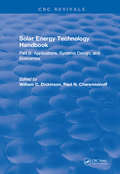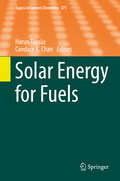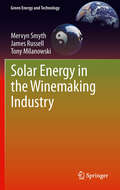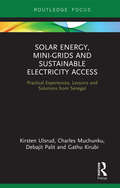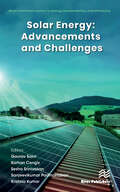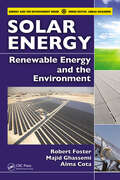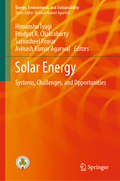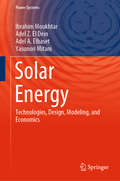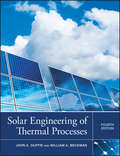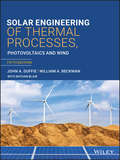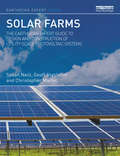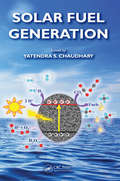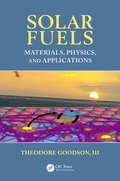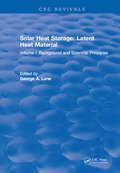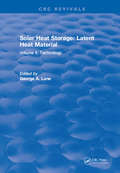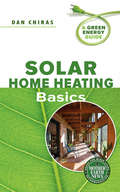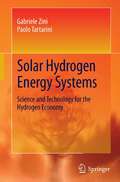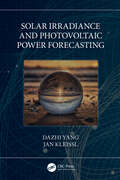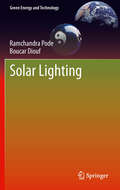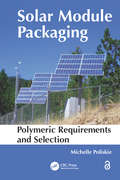- Table View
- List View
Solar Energy Technology Handbook
by E. W. DickinsonThe handbook, for convenient use, is divided into eight main units: (1) The Solar Resource; (2) Solar Thermal Collectors; (3) Photovoltaics; (4) Bioconversion; (5) Wind Energy; (6) Solar Energy Storage Systems; (7) Applications of Solar Energy; (8) Non-technical Issues. In addition there are three Appendixes containing unit-conversion tables and useful solar data. It became obvious early in this project that if proper coverage were to be given each of these areas it would be necessary to divide the handbook into two volumes. The first six units constitute Part A, Engineering Fundamentals and the last two units constitute Part B, Applications, Systems Design, and Economics. These volumes have been prepared primarily as reference books, but it is felt that many of the sections will prove useful for practicing engineers, scientists and students.
Solar Energy at Urban Scale
by Benoit BeckersIncreasing urbanization throughout the world, the depletion of fossil fuels and concerns about global warming have transformed the city into a physical problem of prime importance. This book proposes a multi-disciplinary and systematic approach concerning specialities as different as meteorology, geography, architecture and urban engineering systems, all surrounding the essential problem of solar radiation. It collects the points of view of 18 specialists from around the world on the interaction between solar energy and constructions, combining territorial, urban and architectural scales to better regulate energetic efficiency and light comfort for the sustainable city. The main subjects covered are: measures and models of solar irradiance (satellite observations, territorial and urban ground measurements, sky models, satellite data and urban mock-up), radiative contribution to the urban climate (local heat balance, radiative-aerodynamics coupling, evapotranspiration, Urban Heat Island), light and heat modeling (climate-based daylight modeling, geometrical models of the city, solar radiation modeling for urban environments, thermal simulation methods and algorithms) and urban planning, with special considerations for solar potential, solar impact and daylight rights in the temperate, northern and tropical climates, and the requirement of urban solar regulation. Contents 1. The Odyssey of Remote Sensing from Space: Half a Century of Satellites for Earth Observations, Théo Pirard. 2. Territorial and Urban Measurements, Marius Paulescu and Viorel Badescu. 3. Sky Luminance Models, Matej Kobav and Grega Bizjak. 4. Satellite Images Applied to Surface Solar Radiation Estimation, Bella Espinar and Philippe Blanc. 5. Worldwide Aspects of Solar Radiation Impact, Benoit Beckers. 6. Local Energy Balance, Pierre Kastendeuch. 7. Evapotranspiration, Marjorie Musy. 8. Multiscale Daylight Modeling for Urban Environments, John Mardaljevic and George Janes. 9. Geometrical Models of the City, Daniel G. Aliaga. 10. Radiative Simulation Methods, Pierre Beckers and Benoit Beckers. 11. Radiation Modeling Using the Finite Element Method, Tom van Eekelen. 12. Dense Cities in the Tropical Zone, Edward Ng. 13. Dense Cities in Temperate Climates: Solar and Daylight Rights, Guedi Capeluto. 14. Solar Potential and Solar Impact, Frédéric Monette and Benoit Beckers. Appendix 1. Table of Europe’s Platforms (Micro- and Minisatellites) for Earth Observations, Théo Pirard. Appendix 2. Commercial Operators of Earth Observation (EO) Satellites (as of January 1, 2012), Théo Pirard. Appendix 3. Earth’s Annual Global Mean Energy Budget, Benoit Beckers.
Solar Energy for Fuels
by Harun Tüysüz Candace K. ChanThe series Topics in Current Chemistry presents critical reviews of the present and future trends in modern chemical research. The scope of coverage is all areas of chemical science including the interfaces with related disciplines such as biology, medicine and materials science. The goal of each thematic volume is to give the non-specialist reader, whether in academia or industry, a comprehensive insight into an area where new research is emerging which is of interest to a larger scientific audience. Each review within the volume critically surveys one aspect of that topic and places it within the context of the volume as a whole. The most significant developments of the last 5 to 10 years are presented using selected examples to illustrate the principles discussed. The coverage is not intended to be an exhaustive summary of the field or include large quantities of data, but should rather be conceptual, concentrating on the methodological thinking that will allow the non-specialist reader to understand the information presented. Contributions also offer an outlook on potential future developments in the field. Review articles for the individual volumes are invited by the volume editors. Readership: research chemists at universities or in industry, graduate students
Solar Energy in the Winemaking Industry
by James Russell Mervyn Smyth Tony MilanowskiSolar Energy in the Winemaking Industry fully documents all aspects of the modern solar winery, beginning with the main drivers (environmental, economic and political) and detailing the current winemaking industry and solar technologies available. It details the various energy demands in the winemaking process from harvest to bottling and beyond. Solar Energy in the Winemaking Industry catalogues the range of wineries globally that have installed a substantial solar collecting system and uses case study material to give the reader an appreciation of the diversity of solar winery facilities. From large industrial-style wineries to boutique family-run wineries; from new state-of-the-art facilities to 15th-century palaces, the application for solar is limitless. The book deals finally with the physical design, installation and operation of the solar system within the winery environment, detailing the equipment, methodologies, processes and concerns that must be addressed in their creation. This presents the reader with a range of solar design and system options, including: generic system type; installation; mounting arrangements; operation; different module and inverter components and configurations; connection; and finance. Owners, managers and planners involved in the design, building or management of a winemaking facility will derive particular benefit from Solar Energy in the Winemaking Industry, but it will also be of interest to anyone with an interest in the wine or solar industries.
Solar Energy, Mini-grids and Sustainable Electricity Access: Practical Experiences, Lessons and Solutions from Senegal (Routledge Focus on Environment and Sustainability)
by Debajit Palit Kirsten Ulsrud Charles Muchunku Gathu KirubiThis book presents new research on solar mini-grids and the ways they can be designed and implemented to provide equitable and affordable electricity access, while ensuring economic sustainability and replication. Drawing on a detailed analysis of solar mini-grid projects in Senegal, the book provides invaluable insights into energy provision and accessibility which are highly relevant to Sub-Saharan Africa, and the Global South more generally. Importantly, the book situates mini-grids in rural villages within the context of the broader dynamics of national- and international-level factors, including emerging system innovation and socio-technical transitions to green technologies. The book illustrates typical challenges and potential solutions for practitioners, policymakers, donors, investors and international agencies. It demonstrates the decisive roles of suitable policies and regulations for private-sector-led mini-grids and explains why these policies and regulations must be different from those that are designed as part of an established, centralized electricity regime. Written by both academics and technology practitioners, this book will be of great interest to those researching and working on energy policy, energy provision and access, solar power and renewable energy, and sustainable development more generally.
Solar Energy: Advancements and Challenges (River Publishers Series in Energy Sustainability and Efficiency)
by Krishna Kumar Gaurav Saini Korhan Cengiz Sanjeevikumar Padmanaban Sesha SrinivasanEnergy is a key source of economic growth due to its involvement as the primary input. Energy drives economic productivity and industrial growth. It can be considered as the prime requirement for the modern economy. Solar energy is a renewable source of energy that can be used to produce heat or generate electricity. The total amount of solar energy available on Earth’s surface is vastly in excess of the world’s current and anticipated energy requirements. In the 21st century, solar energy is expected to become increasingly attractive as a renewable energy source. An increase in the share of solar energy may destabilize the grid. To overcome the issues of grid instability, specifically in remote areas, BIM and GIS-based microgrid planning based on data can be effectively used. BIM and GIS are used to assess alternative solutions and big data analytics in building solar electrical systems according to planning requirements and managing assets. The integration of BIM and GIS information systems for microgrid planning is appealing due to its potential benefits, such as it decreases the microgrid planning time and cost. The present book is about the advancements in technology for harnessing solar energy and the challenges associated with different modes of utilizing this inexhaustible renewable energy source. This book will be helpful for researchers, academicians, technologists, innovators, and industry experts working in the area of solar energy, artificial intelligence, and smart grids.
Solar Energy: Made Simple for a Sustainable Future (Green Energy and Technology)
by Malti Goel V. S. Verma Neha Goel TripathiThis book presents the achievements made in solar energy and prospects in achieving solar potential in India. It covers the historical perspectives, innovations and myriad applications of solar energy in its different forms. The book discusses solar devices and covers both solar photovoltaics and solar thermal energy and includes both heat and electricity applications. Solar policies in India, solar research, technologies, large scale adoption as well as future trends are also discussed. This book will be useful for researchers and professionals with interests in technological, economical and policy developments in solar energy driven power industry.
Solar Energy: Renewable Energy and the Environment (ISSN)
by Robert Foster Majid Ghassemi Alma CotaDrawing on the authors' extensive research and project implementation around the globe, this book provides detailed knowledge for converting solar radiation into a suitable energy supply. It presents technical fundamentals to give a clear understanding of how solar energy can be captured for later use. The authors examine thermosolar collectors, photovoltaics modules, and other important types of solar receivers as well as cover typical cost-effective applications, including water pumping, residential electrification, lighting, small-scale irrigation, and more. Examples, case studies, and lessons learned from technical failures illustrate how to best implement solar energy projects.
Solar Energy: Systems, Challenges, and Opportunities (Energy, Environment, and Sustainability)
by Avinash Kumar Agarwal Himanshu Tyagi Prodyut R. Chakraborty Satvasheel PowarThis book covers challenges and opportunities related to solar-energy based systems. It covers a wide variety of topics related to solar energy, including applications-based systems such as solar thermal systems that are focused on drying, desalination, space cooling, refrigeration, and processing; recent advances in solar cells (DSSC) and photovoltaics; technologies for storage of energy (both sensible heating as well as latent heating); and the design of concentrated solar receivers. The information is presented in the context of the overall global energy utilization, and the role of solar energy has been highlighted. The contents of this book will be of interest to researchers, professionals, and policymakers alike.
Solar Energy: Technologies, Design, Modeling, and Economics (Power Systems)
by Adel A. Elbaset Yasunori Mitani Ibrahim Moukhtar Adel Z. El DeinThis book opens with a brief introduction to renewable energy and the advantages of solar energy systems, an overview of concentrated solar power (CSP) system technologies and modeling, and the application of artificial neural network (ANN) technologies in various solar field systems. Later chapters cover data and operation methods of central tower receiver power plants (CTRPP), important models of ANN techniques used in solar energy fields, accurate methods for modeling CTRPP, the economics of solar energy systems, the CSP impacts on the penetration level of photovoltaic (PV) systems, and a look at the reliability of systems using case studies on PV systems and hybrid PV and CSP systems.Provides an introduction to renewable energy and the advantages of solar energy systemsOutlines methods for modeling central tower receiver power plantsIncludes case studies on photovoltaic (PV) and hybrid PV and concentrated solar power systems
Solar Energy: The State of the Art
by Jeffrey GordonIt is rare that a book draws together the knowledge and experience of scientists, each a world leader in his or her discipline, to create a work that presents the state of the art in a field as rich and diverse as solar energy. In Solar Energy - the State of the Art this aim has been achieved. The book comprises twelve individual chapters, each dedicated to one of the major solar energy sub-disciplines and authored by an internationally recognised expert in the field. Areas covered range from solar radiation and meteorology, solar collectors and concentrators, solar energy and the built environment, to solar thermal electricity, photovoltaics, wind energy and the potential cost of ignoring solar energy resources. The papers examine the technology and field in question, discuss the rudiments and major applications, review the current science and technology and explore the remaining challenges for the future. Solar Energy - the State of the Art is an essential reference work for all solar energy practitioners, students, researchers and engineers wishing to gain a broad-based understanding of the theory, technology, applications and issues surrounding the broad, interdisciplinary field of solar energy. The book will form an important component of any library's solar energy holding and will be of particular benefit as an academic reference, as well as being of practical value to professionals who wish to gain a clear understanding of the concepts required to move forward in this field. Published with ISES.
Solar Engineering of Thermal Processes
by William A. Beckman John A. DuffieThe updated fourth edition of the "bible" of solar energy theory and applicationsOver several editions, Solar Engineering of Thermal Processes has become a classic solar engineering text and reference. This revised Fourth Edition offers current coverage of solar energy theory, systems design, and applications in different market sectors along with an emphasis on solar system design and analysis using simulations to help readers translate theory into practice.An important resource for students of solar engineering, solar energy, and alternative energy as well as professionals working in the power and energy industry or related fields, Solar Engineering of Thermal Processes, Fourth Edition features:Increased coverage of leading-edge topics such as photovoltaics and the design of solar cells and heatersA brand-new chapter on applying CombiSys (a readymade TRNSYS simulation program available for free download) to simulate a solar heated house with solar- heated domestic hot waterAdditional simulation problems available through a companion websiteAn extensive array of homework problems and exercises
Solar Engineering of Thermal Processes, Photovoltaics and Wind
by William A. Beckman John A. Duffie Nathan BlairThe bible of solar engineering that translates solar energy theory to practice, revised and updated The updated Fifth Edition of Solar Engineering of Thermal Processes, Photovoltaics and Wind contains the fundamentals of solar energy and explains how we get energy from the sun. The authors—noted experts on the topic—provide an introduction to the technologies that harvest, store, and deliver solar energy, such as photovoltaics, solar heaters, and cells. The book also explores the applications of solar technologies and shows how they are applied in various sectors of the marketplace. The revised Fifth Edition offers guidance for using two key engineering software applications, Engineering Equation Solver (EES) and System Advisor Model (SAM). These applications aid in solving complex equations quickly and help with performing long-term or annual simulations. The new edition includes all-new examples, performance data, and photos of current solar energy applications. In addition, the chapter on concentrating solar power is updated and expanded. The practice problems in the Appendix are also updated, and instructors have access to an updated print Solutions Manual. This important book: • Covers all aspects of solar engineering from basic theory to the design of solar technology • Offers in-depth guidance and demonstrations of Engineering Equation Solver (EES) and System Advisor Model (SAM) software • Contains all-new examples, performance data, and photos of solar energy systems today • Includes updated simulation problems and a solutions manual for instructors Written for students and practicing professionals in power and energy industries as well as those in research and government labs, Solar Engineering of Thermal Processes, Fifth Edition continues to be the leading solar engineering text and reference.
Solar Farms: The Earthscan Expert Guide to Design and Construction of Utility-scale Photovoltaic Systems (Earthscan Expert)
by Christopher Martell Susan Neill Geoff StapletonThe market and policy impetus to install increasingly utility-scale solar systems, or solar farms (sometimes known as solar parks or ranches), has seen products and applications develop ahead of the collective industry knowledge and experience. Recently however, the market has matured and investment opportunites for utility-scale solar farms or parks as part of renewable energy policies have made the sector more attractive. This book brings together the latest technical, practical and financial information available to provide an essential guide to solar farms, from design and planning to installation and maintenance. The book builds on the challenges and lessons learned from existing solar farms, that have been developed across the world, including in Europe, the USA, Australia, China and India. Topics covered include system design, system layout, international installation standards, operation and maintenance, grid penetration, planning applications, and skills required for installation, operation and maintenance. Highly illustrated in full colour, the book provides an essential practical guide for all industry professionals involved in or contemplating utility-scale, grid-connected solar systems.
Solar Fuel Generation
by Yatendra S. ChaudharyAs the search for renewable sources of energy grows more urgent, more and more attention is focusing on the blueprint offered by biological photosynthesis for translating the energy of our Sun into energy rich molecules like H2 and carbohydrates, commonly known as "solar fuels." These solar fuels have enormous potential to store high densities of energy in the form of chemical bonds as well as being transportable. This book offers a complete overview of the promising approaches to solar fuel generation, including the direct pathways of solar H2 generation and CO2 photocatalytic reduction. Solar Fuel Generation is an invaluable tool for graduate students and researchers (especially chemists, physicists, and material scientists) working in this field.
Solar Fuels: Materials, Physics, and Applications
by Iii Theodore GoodsonWritten for use as a text and reference for those interested in how new materials may be used to capture, store, and use solar energy for alternative energy resources in everyday life, Solar Fuels: Materials, Physics, and Applications discusses the fundamentals of new materials and the physical processes involved in their mechanisms and design. This book offers clear examples of current state-of-the-art organic and inorganic solar cell materials and devices used in the field, and includes experiments testing solar capability along with standardized examples. Last, but not least, it also gives a clear outline of the challenges that need to be addressed moving forward.
Solar Heat Storage: Volume I: Latent Heat Material
by LaneSeveral hundred technically acceptable PCMs were identified in Volume I of this set, and some of their thermodynamic and physical properties were present. Out of these, practical considerations have reduced the list to a few commercial PCMs for solar energy thermal storage heating and cooling applications. In Volume II these PCMs and their technology and discussed.
Solar Heat Storage: Volume II: Latent Heat Material
by G.A. LaneSeveral hundred technically acceptable PCMs were identified in Volume I of this set, and some of their thermodynamic and physical properties were present. Out of these, practical considerations have reduced the list to a few commercial PCMs for solar energy thermal storage heating and cooling applications. In Volume II these PCMs and their technology and discussed.
Solar Home Design Manual for Cool Climates
by Shawna Henderson Don RoscoeIf you want an inexpensive, environmentally sound source of energy for your home, you need look no further than the sun. Solar heat is not subject to rate increases, is totally renewable, pollution free and requires little or no technology. It is here for you today, and can easily provide up to 50% of your space and water heating requirements. This is a book that simply and clearly explains the principles of using solar energy to heat your home. Anyone building a new home, or renovating an old one can incorporate one or several aspects of solar energy into their design. Taking you through the process of designing a solar home from the ground up this manual is also a basic course in conservation and sustainable house design. If you live in a 'heating' climate, meaning if you have space heating requirements for most of the year then this is an invaluable resource. A house is the biggest single investment most of us will make in our lives - the way it is built and how it operates can reflect a long term investment in both the building and the planet.
Solar Home Heating Basics
by Dan ChirasAs fossil fuel supplies dwindle, home heating will be one of the major challenges in temperate and cold climates in upcoming years. The reserves of natural gas used to heat the majority of North American buildings are rapidly being depleted. This latest Green Energy Guide helps readers who want to slash their energy bills and reduce their dependence on scarce resources to navigate the sometimes confusing maze of clean, reliable, and affordable options.Solar Home Heating Basics focuses on renewable energy strategies to heat new and existing homes and small businesses. These include:*Energy efficiency, weatherization, and insulation*Solar hot air heating*Solar thermal systems*Passive solar heating*Backup heating systemsWhile most solar home heating resources are geared primarily towards new buildings, this practical guide addresses ways of retrofitting existing buildings, making solar a reality for many people.Packed with all the essential information home and small business owners need to find alternatives to conventional heating solutions, Solar Home Heating Basics is your key to a personal energy solution.Dan Chiras is a respected educator and the author of thirty books on residential renewable energy and green building, including The Homeowner's Guide to Renewable Energy and Power from the Sun. Dan is the director and lead instructor at the Evergreen Institute's Center for Renewable Energy and Green Building, where he teaches workshops on energy efficiency, solar electricity, solar hot water, small wind energy, green building, natural plasters, and natural building.
Solar Hydrogen Energy Systems
by Paolo Tartarini Gabriele ZiniIt is just a matter of time when fossil fuels will become unavailable or uneconomical to retrieve. On top of that, their environmental impact is already too severe. Renewable energy sources can be considered as the most important substitute to fossil energy, since they are inexhaustible and have a very low, if none, impact on the environment. Still, their unevenness and unpredictability are drawbacks that must be dealt with in order to guarantee a reliable and steady energy supply to the final user. Hydrogen can be the answer to these problems. This book presents the readers with the modeling, functioning and implementation of solar hydrogen energy systems, which efficiently combine different technologies to convert, store and use renewable energy. Sources like solar photovoltaic or wind, technologies like electrolysis, fuel cells, traditional and advanced hydrogen storage are discussed and evaluated together with system management and output performance. Examples are also given to show how these systems are capable of providing energy independence from fossil fuels in real life settings.
Solar Irradiance and Photovoltaic Power Forecasting (Energy Analytics)
by Dazhi Yang Jan KleisslForecasting plays an indispensable role in grid integration of solar energy, which is an important pathway toward the grand goal of achieving planetary carbon neutrality. This rather specialized field of solar forecasting constitutes both irradiance and photovoltaic power forecasting. Its dependence on atmospheric sciences and implications for power system operations and planning make the multi-disciplinary nature of solar forecasting immediately obvious. Advances in solar forecasting represent a quiet revolution, as the landscape of solar forecasting research and practice has dramatically advanced as compared to just a decade ago. Solar Irradiance and Photovoltaic Power Forecasting provides the reader with a holistic view of all major aspects of solar forecasting: the philosophy, statistical preliminaries, data and software, base forecasting methods, post-processing techniques, forecast verification tools, irradiance-to-power conversion sequences, and the hierarchical and firm forecasting framework. The book’s scope and subject matter are designed to help anyone entering the field or wishing to stay current in understanding solar forecasting theory and applications. The text provides concrete and honest advice, methodological details and algorithms, and broader perspectives for solar forecasting. Both authors are internationally recognized experts in the field, with notable accomplishments in both academia and industry. Each author has many years of experience serving as editors of top journals in solar energy meteorology. The authors, as forecasters, are concerned not merely with delivering the technical specifics through this book, but more so with the hopes of steering future solar forecasting research in a direction that can truly expand the boundary of forecasting science.
Solar Light-to-Hydrogenated Organic Conversion: Heterogeneous Photocatalysts
by Hairus AbdullahThis book highlights the promising photocatalytic methods for synthesizing organic chemicals by simultaneously degrading the toxicity of raw substances used for organic synthesis. It presents various semiconducting materials with high catalytic activities in hydrogen evolution reactions (HERs) and hydrogenation reactions, as well as the material characterizations for identifying semiconductor photocatalysts. The focus is on understanding the hydrogen dissociation and activation of substances in the process of hydrogenation and the fabrication of nanostructured catalysts with desired activity and selectivity. Recent works show photocatalytic hydrogenation reactions with in situ generated H+ on catalyst surfaces utilizing initial chemicals such as nitrophenol, nitrobenzene, azobenzene, and benzene for valorization. In addition, the photocatalytic valorization of waste glycerol is also discussed. Besides the hydrogenation reactions, the reduction of oxygen to form H2O2 can be done with a photocatalytic method in atmospheric conditions. Some related perspectives and outlooks are also discussed for possible future development.
Solar Lighting
by Ramchandra Pode Boucar DioufLimited availability of grid-based electricity is a major challenge faced by many developing countries, particularly the rural population. Fuel-based lighting, such as the kerosene lantern, is widespread in these areas, but it is a poor alternative, contributing to global warming and causing serious health problems. Several developing countries are therefore now encouraging the use of sustainable lighting. Solar Lighting gives an in-depth analysis of energy-efficient light production through the use of solar-powered LED systems. The authors pay particular attention to the interplay between energy transformation and device efficiency. They also discuss diverse aspects of renewable energy, including how an improvement in the efficiency of appliances can reduce the cost of energy. Solar Lighting is written for physicists, environmental experts and lighting engineers. It is also suitable for undergraduate students in the fields of environmental science, electrical engineering and renewable energy.
Solar Module Packaging: Polymeric Requirements and Selection
by Michelle PoliskieExploring current and future opportunities in PV polymeric packaging, this work offers an insider's perspective on the manufacturing processes and needs of the solar industry and reveals opportunities for future material development and processing. Suitable for nonspecialists in polymer science, it provides a basic understanding of polymeric concepts, fundamental properties, and processing techniques commonly used in solar module packaging. The book also presents guidelines for using polymers in commercial PV modules as well as the tests required to establish confidence in the selection process.
